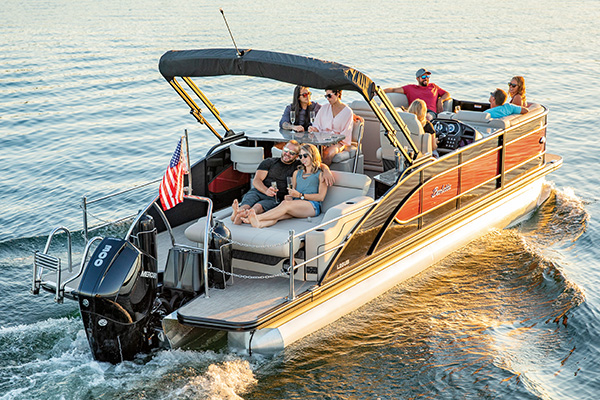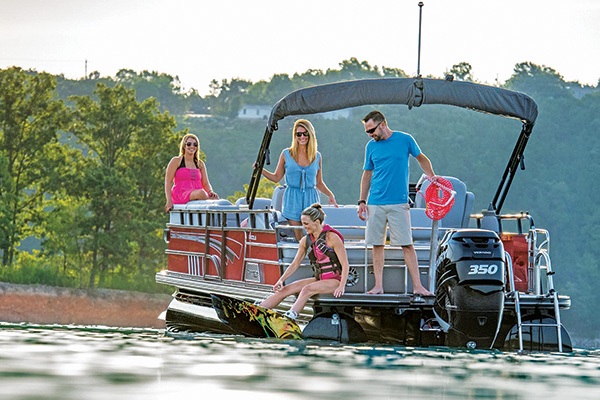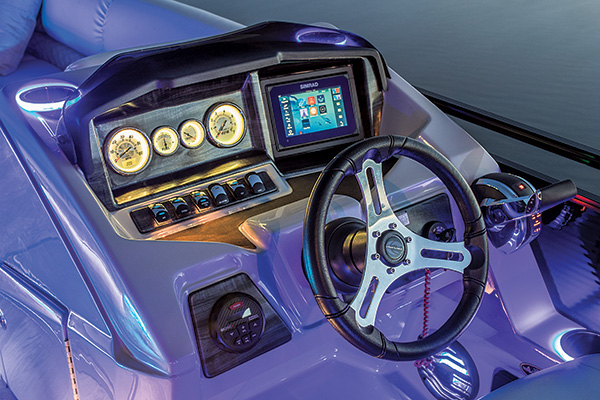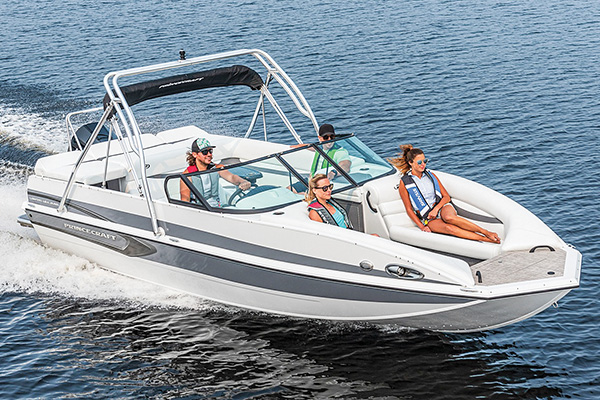Market Trends: Room for everyone

By Adam Quandt
Industry leaders across the recreation marine sector regularly preach the importance of selling the experience of boating, rather than just simply selling the product.
With generous room aboard and the ever-increasing versatility of both pontoons and deck boats, manufacturers within these segments of the industry are consistently striving to provide the experience of boating to the many over the few.
Consumers continue to find more and more options when shopping within both the pontoon and deck boat segments of the industry. From multiple floor plans with various seating and entertaining options to watersports packages and everything in between, variety is the name of the game.
By the numbers
During our last look at the pontoon segment, it was nothing but growth predicted from sources such as Statistical Surveys, Inc. (SSI) and Info-Link, however with most of the country’s season affected by weather, the pontoon segment — along with almost every other segment — felt some slowing.
“We didn’t see any regions necessarily outperforming others,” Rusty Kucher, category director of pontoons at Brunswick Corporation, said. “Weather was definitely the biggest contributing factor. “From weather affecting the boat show season and a very wet spring contributing to a later start of the boating season, weather had a large impact on the 2019 boater.”
Sales within the pontoon boat segment were down 2.47% in the 12-month period ending in September 2019, according to the latest data from Statistical Surveys, Inc.
Over half of the markets posted at least single-digit decreases, with two markets posting double-digit decreases.
Despite decreases in many areas, the pontoon segment remained strong in the Milwaukee, Wis. market (up 7.33%) and in Knoxville, Tenn. (up 4.7%).
Similar to the pontoon segment overall, sales within the deck boat sector of the industry were down 9.34% in the same 12-month period. However, a handful of markets experienced tremendous growth within the period, like the West Palm Beach and Boca Raton, Fla. market (up 76.09%), Chicago, Ill. (up 27.87%) and Orlando, Fla. (up 15.74%).
Regardless of the slightly slowing pace, the National Marine Manufacturers Association (NMMA) recently released its annual report stating overall retail unit sales of new powerboats are estimated to have held stead in 2019. The association estimates an approximate 280,000 units for 2019, which is still the second highest total since 2007, and both the pontoon and deck boat segments were sure to have a contribution to those numbers.
Fully staffed
Much like almost every other segment of the recreational boating industry, the pontoon and deck boat segments are seeing more and more players enter the game in terms of manufacturers.
We’re seeing marine groups dabble in both pontoons and deck boats (and beyond), focused on providing the boating experience for all.
Polaris Industries Inc. continues to move forward after re-entering the boating industry in May 2018 with the acquisition of Boat Holdings, LLC. Providing variety to consumers through brands such as Bennington and Godfrey on the pontoon side and Hurricane on the deck boat side.
Similarly, White River Marine Group has taken aim at providing the boating experience to the many across a multitude of segments within the industry, including Ranger, Sun Tracker and Regency being pontoon focused and brands like Tahoe with deck boat focus.
Also on the group side, marine-industry giant Brunswick Corporation takes hitting these segments to a new level, with six brands offering pontoon models (Crestliner, Cypress Cay, Harris, Lowe, Lund and Princecraft) and three brands offering deck boat models (Bayliner, Sea Ray and Princecraft).
“As a whole, each brand has its purpose and place,” Kucher said of the Brunswick pontoon brands. “From brand loyalists to value hunters, to simple ease of getting on the water, you have to hit them all.”
Yet it’s not just big marine groups in play within both segments.
Manufacturers like Crownline, Starcraft and Stingray Boats continue to push the deck boat market forward. And others like Avalon, Barletta and Misty Harbor propel the pontoon market into the future.
Barletta alone recently announced its creation of a new, dedicated space for research and development as a means to invest in the future of pontoons. And along with the new facility, Barletta brought on a new director of design and development, Josiah Druckenmiller, formerly of Bennington Marine.
“We’ve been working diligently on a sensible expansion plan that will help us improve our efficiencies as well as contribute to the quality of the pontoon boats we build,” Barletta president and co-owner Bill Fenech said during the announcement. “We’re not going to build just to build. Any type of expansion plan will only be considered if we know that it will support and benefit our dealers, our customers, and our internal teams.”
Family-focused and beyond

While the general idea of both pontoons and deck boats has been aimed at getting family, friends, everyone on the water at once, pontoons especially have branched out to become extremely versatile vessels.
“We hit different customers through different brands, not just different models within those brands,” Kucher said.
Deck boats continue to take the operational feel of a modern runabout through hull design with the layout and space of a pontoon. With that, manufacturers continuously show the segments versatility to tackle everything from watersports to fishing and everything else a consumer could want.
Within Brunswick’s portfolio, Harris pontoons take aim at the luxury lifestyle through variety and optional features to entertain friends, where Lowe handles the value side and focus on the family. On yet another aspect, Lund takes aim at those who live to fish, but still wish to have a family-focused boat. “That’s not to say each brand doesn’t cross over in one way or another,” Kucher added.
Ranger, a brand known globally for its popular fishing boats, recently unveiled a brand new series of luxury pontoons, the LS Series. The tritoons from Ranger showcase a wide variety of features aimed at breaking the stereotype that Ranger only produces fishing boats. The two new models have horsepower ratings up to 400 on the 2500 and 250 in the 2300. Behind each lounge backrest is Ranger’s DoubleUP seating storage that offers extra stowage, and two integrated Ranger-branded soft-sided coolers that come standard. In addition, a center locker holds skis, ropes and a tow pylon for quick access, while a changing enclosure is housed within the port lounge of the 2300 and in the aft couch of the 2500.
In a completely new fashion, pontoon manufacturers are breaking more stereotypes about the segment by bringing watersports, specifically surfing, into the picture.
Last year, the industry saw the introduction of a surfable pontoon from Minnesota’s Montara Boats. The company’s Surf Boss uses the power from PCM inboard engines and a high amount of ballast, to bring wakeboat capabilities to a space-friendly pontoon layout. In the first few months after introduction, Montara Boats signed 27 dealers, with an additional 23 dealerships pending at the time.
Most recently, Avalon launched a wakesurf pontoon of its own at the Minneapolis Boat Show in late January. The manufacturer’s Waketoon-Surf Series is the result of collaboration with Volvo Penta, by adapting the engine manufacturer’s Forward Drive system. The new triton features an integrated rocker and shape, along with contoured wake plates to enable an optimum waterflow for surfing. A unique variable trim system paired with the Volvo Penta V-8 I/O eliminates the need for a heavy ballast tank system that can often degrade handling.
Regardless of what the boat’s focus is on — cruising, fishing, watersports, etc. — today’s consumer in the pontoon market wants options.
Across the board, pontoon manufacturers are offering increasing variety to a multitude of models. Different floorplan layouts, additional entertainment options from tables to bars and beyond, enhanced technology, and more, a custom-feeling vessel keeps consumers happy.
“The pontoon customer continuously wants increased choice of options,” Kucher said. “They want to make it theirs and that’s an ongoing trend I believe will only continue well into the future.”
Smart boat

In the era of smart everything, it’s no surprise that consumers expect more out of a boat in terms of technology. While pontoons may not always be at the forefront of everyone’s mind when it comes to implementing the newest technology, the segment is adapting some technology from other sectors and leading the way in some tech of its own.
“As smart homes and smart tech in general becomes more prevalent in our daily lives, we need to provide consumers a seamless transition from smart house to smart boat,” Kucher said. “And really, it just depends on the feature. Some come from other segments of the industry and others are definitely specific to pontoons.”
Kucher said for most manufacturers, it is a price point matter in regards to incorporating technology across a multitude of models. “A lot of it begins with upper-level yachts and large fishing boats and as the tech becomes easier to produce, it gets filtered down and adapted to other various segments.”
With the company’s acquisition of CZone, among many other tech solution providers, Brunswick has placed a large emphasis on integrating technology into all of its boat brands. However, the company recently really dug into a new level with Harris Pontoons’ new Solstice models.
Both the 230 and the 250 Solstice models are the first Harris pontoons to offer CZone digital switching capabilities with what Brunswick labels “best-in-class” electrical infrastructure. The pre-programmed, single-touch modes give the boater control of the onboard electrical systems, offering a significantly enhanced experience with modern day luxury infused with intuitive technology for every family. CZone functionality and modes can be changed, programmed and updated in real-time – ideal not just for the boat builder, but for the novice and advanced boater on the water. Additional features of CZone digital switching include pre-programmed, single-button click modes such as: Party Mode, Swimming Mode, Cruising Mode and more.
Many builders in both the pontoon and deck boat segments are implementing new and improved technology across a multitude of models.
For example, Bennington Marine is providing customers with a well thought out experience by offering upgraded sound systems to an integrated digital helm within a variety of the builder’s models.
While many technology applications aim to keep being on the water entertaining, like audio options, lighting and more, other new tech strives to make boating easier.
As twin-engine applications continue to become more popular within the pontoon segment, many builders such as Bennington and Manitou are offering joystick options to consumers.
Whether for entertainment or ease of operation, one thing is for certain across pontoon and deck boat manufacturers, technology will continue to be implemented more and more in the boating experience.
Full steam ahead

With the weather-stricken season in the rear-view mirror, pontoon and deck boat manufacturers are optimistic about the future.
“We definitely expect some customers who didn’t get a boat last year due to weather to come back this year,” Kucher said.
The annual NMMA report states an expected new powerboat sales increase as much as 2% in 2020.
“Looking at 2020, with the economy on solid footing and key economic indicators like consumer spending remaining strong, we expect another healthy year for new boat sales, which could be up as much as 2%,” said Frank Hugelmeyer, NMMA president. “With approximately $42 billion per year in retail expenditures, boating is not only an economic driver but a unique vehicle for the kind of meaningful experiences consumers are seeking more and more—ones that take you outdoors, bring together family and friends, and create lasting memories.”
The family-friendly and entertainment-focused pontoon and deck boat segments are almost certain to remain strong contributing factors as the industry continues to push the boating experience and lifestyle.




